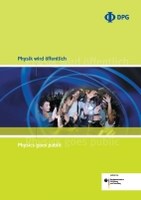Physics goes public
With this brochure, the DPG would like to outline the path taken by "public" physics in Germany since the Year of Physics 2000.

Richard Feynman, physicist and Nobel Prize laureate, once spoke about “the pleasure of finding things out”. This pleasure has been natural science’s companion for centuries inspiring some brilliant minds, such as Galileo, Newton, Darwin or Einstein, who are all linked to our cultural history. Moreover, science – and physics particularly – has always paved the way for technical developments which are largely taken for granted in today’s world. However, towards the end of the 1990s, the Deutsche Physikalische Gesellschaft (German Physical Society, DPG) recognised that public awareness of physics was steadily dwindling. In addition, young people were beginning to believe that studying physics held few prospects for their future – the subject was becoming increasingly unfashionable. As a result, the DPG in cooperation with other scientific organisations and the Federal Ministry of Education and Research (BMBF) in Germany, decided to revitalise its dialogue with the general public. In 2000, all these endeavours culminated in the “Year of Physics”. By publishing this brochure, the DPG aims to outline the path taken by ‘public’ physics in Germany since then. I would like to thank the BMBF without whose support the “Year of Physics”, the “Highlights of Physics” series of festivals and other activities would never have been possible. On the other hand “Wissenschaft im Dialog” (Science in Dialogue)* has given physics the opportunity to be part of an initiative, which all sciences are now following in Germany. Of course, this has only been possible because of the commitment shown by physicists. Not only have they displayed a great deal of imagination in designing DPG campaigns, they also held numerous successful public events at universities and research centres throughout Germany. In addition, teamwork with PR professionals in developing various concepts for literally bringing physics onto the market has proven particularly fruitful. All these partners together have increased society’s awareness of physics. In hindsight, it can be stated that the “Year of Physics” was a true catalyst. Researchers from all over Germany left their ‘ivory towers’ and presented their research to the public. The media also set a number of things in motion. The growing number of television programmes and magazines which focus on science topics is a clear indication of this. An increasing number of young people is becoming interested in physics once more: the number of new undergraduates studying physics has increased by 50 percent since the “Year of Physics”. However, this positive trend is no reason for us to sit on our laurels. The dialogue with society must continue.
Ludwig Schultz
Executive Board Member for Public Relations, DPG
March 2005
*an iniative of the Federal Ministry of Education and Research, the Donors Association and leading German research organisations